Antler flies
Protopiophila litigata
The antler fly is a small (2-3 mm body length) piophilid that breeds exclusively on shed antlers of cervids such as moose and deer (Bonduriansky 1995; Bonduriansky and Brooks 1999). The antler fly's extreme specialization on this rare resource has resulted in the evolution of remarkable site fidelity: the flies (especially males) typically return to the same antler every day. This behaviour makes it possible--almost uniquely among known insect species--to collect highly detailed longitudinal data on survival and reproduction of these insects in the wild.
|
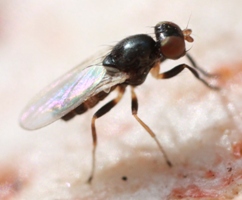
|
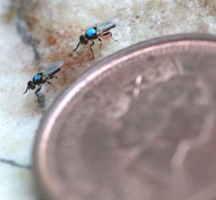
|
Moose antler supporting a population of antler flies.
|
|
Antler flies were discovered at the Algonquin Wildlife Research Station (AWRS) in Algonquin Park, Ontario, and described as a new species in 1995 (Bonduriansky 1995). Research on antler flies continues at the AWRS.
The known distribution of antler flies extends across the eastern part of Canada, from Newfoundland and Cape Breton, Nova Scotia, to southern Ontario. Morphologically similar flies have been collected from moose antlers in Sweden, suggesting that this species (or a closely related congener, with potentially similar ecology) occurs in northern Europe.
|
|
It is possible to mark and measure live antler flies without injury using a restraining device (Bonduriansky & Brooks 1997). Flies can be marked on the thorax with enamel paint and then released on an antler (video). Because males tend to spend every day on the same antler, it is possible to observe them throughout their lives and obtain fairly precise estimates of their lifespan in the wild. Their 2-hour long copulations also make it possible to record matings and estimate lifetime mating success in the wild.
Using mark-resighting techniques, Bonduriansky and Brassil (2002) obtained the first evidence of ageing (senescence) -- declining survival rate and reproductive rate -- and estimated the fitness costs of senescence, in a wild insect population. They also showed that ageing rate is related to body size: large males exhibit faster reproductive ageing than do small males (Bonduriansky & Brassil 2005).
|
|
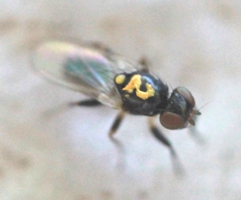
|
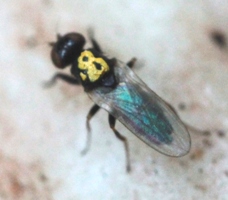
|
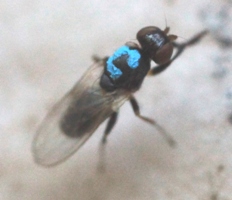
|

|
|
Male antler flies are astonishingly aggressive: litigata translates roughly as 'bellicose'. On antlers, males form complex, highly structured aggregations. Some individuals defend stable territories, while others simply wander in search of females, which arrive on antlers to feed, mate and oviposit (Bonduriansky & Brooks 1998, 1999). In prime areas of the antler, near oviposition sites (cracks in the antler surface), males spend much of their time battling rival males. They even attack insects vastly larger than themselves. This video of an antler fly aggregation was created by Phil Savoie of the BBC-NHU. The photos below show male-male combat.
|
|
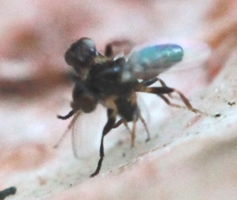
|
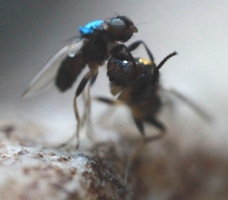
|
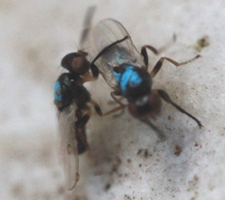
|
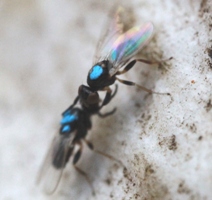
|
|
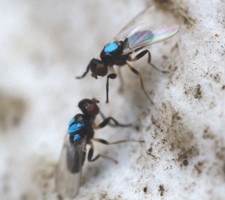
|
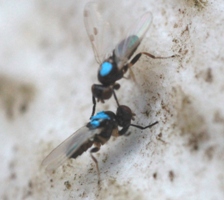
|
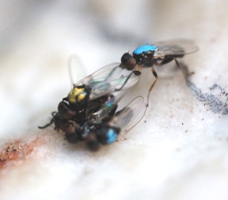
|
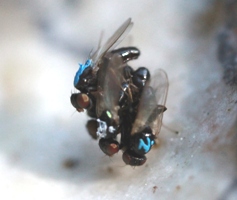
|
|
Antler flies appear to engage in mutual mate choice, with both males and females rejecting some potential mates (Bonduriansky & Brooks 1998). Following copulation, the female expels and ingests much of the male's ejaculate, then inserts her ovipositor into minute cracks or pores in the antler surface and deposits her eggs. During oviposition, the male remains on the female's back and 'guards' her by warding off rival males with his wings (Bonduriansky & Brooks 1998b). Mating and ovipositing pairs are viciously attacked by single males, who attempt to dislodge the male and mate with the female (bottom left photo). Sometimes, several single males attack a female simultaneously (bottom right photo). Such wrestling matches can last for several minutes, and females and males can sustain serious injury.
|
|
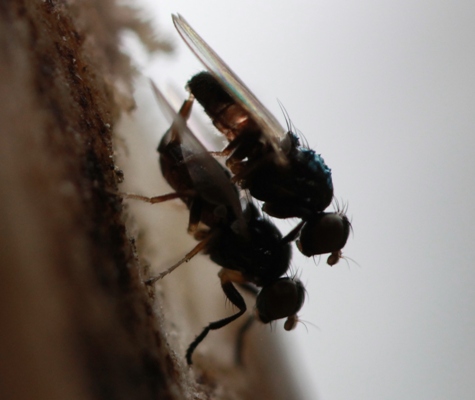
|
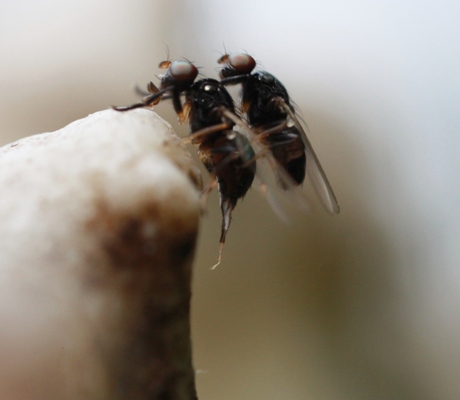
|
|
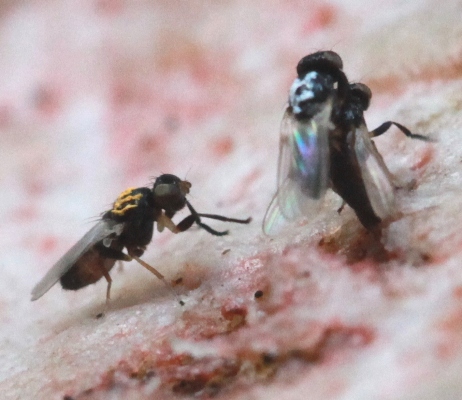
|
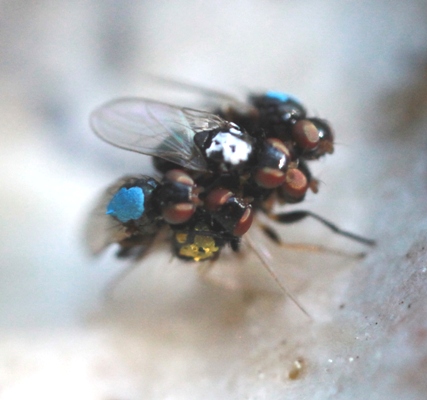
|
|
Antler flies face a wide array of predators on antlers, such as the lacewing larva (left) and spider (right) in the photos below. A predatory empidoid fly with raptorial forelelgs (Tachypeza sp.) also attacks antler flies.
|
|
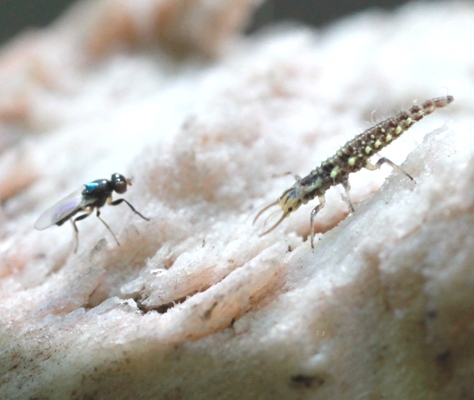
|
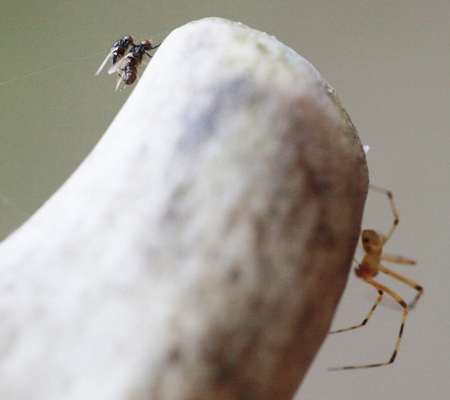
|
|
Antler flies are attacked by parasitic mites, which sometimes undergo explosive outbreaks lasting several days. Some antler fly individuals also have nematode parasites in their abdomens. The photos below show a male heavily infested by mites and missing part of one fore-leg (left), and a female with mites all over her abdomen being mounted by a male (right).
|
|
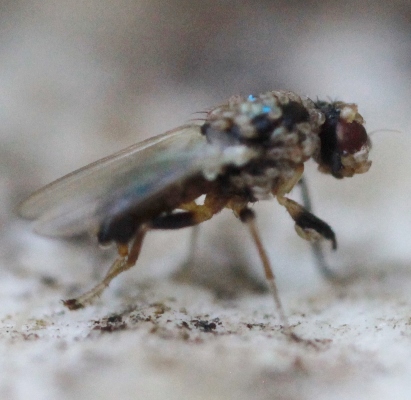
|
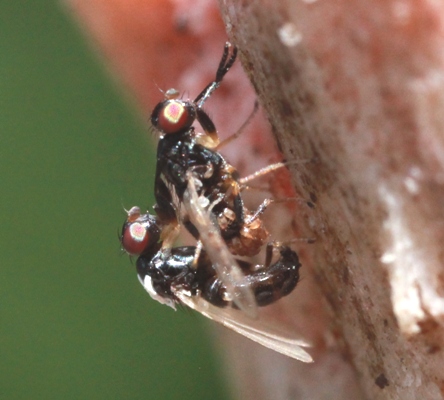
|
|
Antler fly larvae develop in the porous bone matrix inside antlers, and come to the antler surface when ready to pupate. Here, the larvae perform an astonishing leap off the antler surface, as seen in this video. They land on the surrounding leaf-mould, burrow into the soil, and undergo metamorphosis. The photos below, showing an antler fly maggot preparing to leap, were created from footage shot by Phil Savoie, BBC-NHU. The sequence is shown from left to right, and top to bottom: the maggot first raises the anterior part of its body and curves it into a loop, then grasps its posterior end with its mouth-hooks, and tightens its muscles to create tension; finally, the maggot releases its hold abruptly (not shown here), causing its posterior end to recoil against the substrate, and launching itself into flight.
|
|
This amazing behaviour (also exhibited by maggots of several other dipteran families) was first described in the 17th century by the Dutch naturalist Jan Swammerdam, who observed maggots of a relative of antler flies -- the 'cheese skipper' fly Piophila casei (which he called 'the Mite') -- leaping off cheeses and cured meats. Swammerdam wrote:
'When this creature intends to take a leap, it first erects itself upon its anus... Immediately after this, the creature bends itself into a circle, and having brought its head...towards its tail, it presently stretches out its two black crooked claws, and directs them to the cavities formed between the two last or hindmost tubercles of the body, where it fixes them in the skin... The Mite having thus made itself ready, contracts its body with such force, that from a circular, it becomes of an oblong form...the contraction extending in a manner to every part of its body. This done, it again reduces itself with so prodigious a force to a straight line, that its claws, which are seated in the mouth, make a very perceivable noise on parting from the skin of the last ring of the body: and thus the Mite, by first violently bending, and afterwards stretching out its body, leaps to a most extraordinary height, if compared with the smallness of the creature... I have indeed seen a Mite, whose length did not exceed the fourth part of an inch, leap out of a box six inches deep, that is, to a height twenty-four times greater than the length of its own body; others leap a great deal higher.'
Swammerdam, Jan. 1758. The Book of Nature, or, the History of Insects (translated from the Dutch and Latin by Thomas Flloyd). London: C.G. Seyffert.
|
|
Piophila casei infests the popular Sardinian cheese casu marzu, which is eaten together with the leaping maggots.
|
|
The ability to leap may facilitate larval movement from the feeding substrate to pupation sites. Because larval creeping locomotion is excruciatingly slow and rather inefficient, maggots may face considerable energetic costs and, more importantly, great risk of being captured by predatory insects on the surfaces of carcasses or antlers. The ability to leap may represent a solution to both of these problems (Bonduriansky 2002).
|
|
Piophilid maggots are also able to hear and respond to sound. Final instar maggots respond to the sound of a rattle by coming to the surface of their feeding substrate and leaping off. Moisture elicits a similar response. The timing of pupation appears to be facultative in this species, and final instar maggots may wait inside their food substrates (antlers or carcasses) until they perceive stimuli associated with rain (i.e., rattling sound or moisture) before initiating the hazardous migration to their pupation sites. Observations suggest that rain facilitates larval locomotion, and may reduce risk of predation (Bonduriansky 2002).
|
|
Following metamorphosis (which takes about 12 days), adult antler flies emerge from the puparium and usually return to their natal antler. These photos of an antler fly adult emerging from the puparium were created from footage shot by Phil Savoie of the BBC-NHU. After breaking out of the puparium, the adult (which is still soft) repeatedly inflates the anterior part of its head.
|
|
|
| |
|
Research on antler flies is continuing in Howard Rundle's lab at the University of Ottawa. This work has shown that sexual dimorphism in morphological traits is associated with the condition-dependent response of male morphology to larval nutrition (Oudin et al. 2015). Moreover, larval nutrition affects males' mating success and ageing rate: males that have access to abundant nutrients as larvae develop faster and attain a larger adult body size, but also experience more rapid senescence (Angell et al. 2020). Larval diet quality declines in the wild as moose antlers age and the nutrients inside the bone are depleted by antler fly larvae, making older antlers less attractive to adult antler flies (Angell and Rundle 2025).
Chris Angell and collaborators were also able to characterize the cuticular hydrocarbons of antler flies, and to investigate sexual selection on CHCs in wild males over two years. They found evidence of sexual selection on CHC profile in both years, albeit favouring different CHC combinations (Angell et al. 2019).
Antler flies also exhibit effects of paternal age at breeding: offspring of older-breeding males survived longer in the field (Angell et al. 2022).
The unique biology of antler flies also makes it possible to compare life history and effects of dietary macronutrients in wild vs. captive flies. Brian Mautz and colleagues found that captive males live longer and mate more frequently than wild males. However, dietary protein tends to reduce survival in both lab and natural environments (Mautz et al. 2019).
|
| |